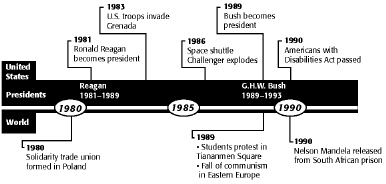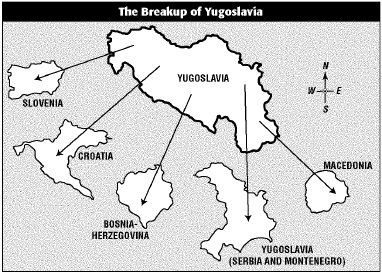Multiple Choice
Identify the
choice that best completes the statement or answers the question.
|
|
|
1.
|
Who was the leader of Iraq during the Persian Gulf War?
a. | Mikhail Gorbachev | c. | Saddam Hussein | b. | Boris Yeltsin | d. | Lech Walesa |
|
|
|
|
|
|
2.
|
 Based on the map, on which one of the following
continents were there no terrorist attacks between 1970 and 2001? a. | Africa | c. | South America | b. | North America | d. | Europe |
|
|
|
3.
|
 Based on the information above, in which countries were
U.S. embassies bombed in 1998? a. | Scotland & East Germany | c. | Saudi Arabia &
Kenya | b. | Lebanon & Syria | d. | Kenya & Tanzania |
|
|
|
4.
|
Who invaded Afghanistan in 1979?
a. | Great Britain | c. | the Soviet Union | b. | China | d. | the United
States |
|
|
|
5.
|
  Base your answer on the time line
above. How many years was Ronald Reagan president of the United States?
|
|
|
6.
|
In the war on terror, the targets of United States strikes were
a. | the Northern Alliance troops. | c. | al-Qaeda and the
Taliban. | b. | Afghani civilians. | d. | Pakistan and India. |
|
|
|
7.
|
Critics ridiculed President Reagan's economic policy, calling it
a. | Ergonomics. | c. | Ron's economics. | b. | Reaganomics. | d. | Ron's Revolution. |
|
|
|
|
|
|
8.
|
 Which of the following states cast the most electoral
votes in the 2000 presidential election? a. | California | c. | Illinois | b. | Texas | d. | New York |
|
|
|
9.
|
 Based on the information above, which of the following
statements about the 2000 presidential election is true? a. | Gore did better in Texas than Bush. | b. | Al Gore won the popular
vote. | c. | George Bush won the popular vote. | d. | Al Gore won Florida’s electoral
votes. |
|
|
|
“The smoke was so bad, I was suffocating. When the buildings toppled, it was like a
volcano.”
–September 11, 2001 | |
|
|
|
10.
|
 What event does this passage by a survivor
describe? a. | the crash of a plane in Pennsylvania | b. | the attack on Kabul by the
Taliban | c. | the attack on the World Trade Center | d. | the bombardment of
Baghdad |
|
|
|
11.
|
Where was the World Trade Center?
a. | New York City | c. | Somerset, Pennsylvania | b. | Seattle,
Washington | d. | Washington,
D.C. |
|
|
|
REALIZATION OF VULNERABILITY
“Today the almost casual acceptance of technology
exploded in a fireball.
“And suddenly,
as a result, people are jolted into realizing once again the extreme vulnerabilities that all humans
must inevitably subject themselves to when they attempt exploration, or even when they are simply
willing to place their fates in the hands of technology.
“The recent space flights were
beginning to seem so matter-of-fact that the television networks ceased their live coverage of
launchings and landings. Newspaper accounts were often relegated to the inside pages. .
.”.
–John Noble Wilford, New York Times,
January 28, 1986 | |
|
|
|
12.
|
 Called “the worst disaster in U.S. space
history,” the event this newspaper article refers to is a. | the near-collision of the Discovery shuttle. | b. | the explosion on
take-off the space shuttle Challenger. | c. | the failure of the Apollo
program. | d. | the crash of Sputnik. |
|
|
|
13.
|
The idea that the world’s economies and societies are all part of one big
system is called
a. | mercantilism. | c. | globalism. | b. | symbiosis. | d. | interconnectedness. |
|
|
|
14.
|
Osama bin Laden is a
a. | moderate fundamentalist. | c. | Tajik prince. | b. | Muslim
fundamentalist. | d. | Pashtun
leader. |
|
|
|
15.
|
The policy of cutting rules and regulations that government agencies place on
businesses is called
a. | Reaganomics. | c. | deregulation. | b. | perestroika. | d. | glasnost. |
|
|
|
16.
|
The leading causes of death in the United States today are
a. | cancer and diabetes. | c. | cancer and heart disease. | b. | diabetes and heart
disease. | d. | heart disease and
stroke. |
|
|
|
17.
|
  Based on the map, how many separate
nations were formed by the breakup of Yugoslavia? a. | eight | c. | five | b. | seven | d. | six |
|
|
|
18.
|
Saddam Hussein's invasion of Kuwait resulted in
a. | the Persian Gulf War. | c. | a coup. | b. | the withdrawal of American
troops. | d. | the breaking of
diplomatic ties. |
|
|
|
19.
|
The September 11, 2001, terrorist attacks included damage to the
a. | Lincoln Memorial. | c. | White House. | b. | Pentagon. | d. | Capitol. |
|
|
|
20.
|
Osama bin Laden became a hero to militant fundamentalists in Afghanistan during
the fight against
a. | India. | c. | the Soviet Union. | b. | the Taliban. | d. | Britain. |
|
|
|
| “. . . In the 1960s in the wake of urban riots and perceived increases in urban
crime, handgun sales increased dramatically from fewer than 750,000 in 1964 to more than 2 million in
1968, where they remain today. Most of the new sales, experts believe, were to fearful homeowners.
Today about half of all American households contain some kind of firearm, and half of them are
handguns. . . .” | |
|
|
|
21.
|
 What event occurred in 1981 that brought further national
attention to efforts to control the millions of handguns in American homes? a. | President Reagan was shot with a handgun in an assassination
attempt. | b. | John Lennon was killed. | c. | Jean Harris murdered Dr. Herman
Tarnower. | d. | Martin Luther King, Jr., was assassinated. |
|
|
|
22.
|
Whose economic plan was perestroika?
a. | Lech Walesa | c. | George H.W. Bush | b. | Ronald Reagan | d. | Mikhail
Gorbachev |
|
|
|
“Honey, I forgot to duck.”
–Ronald
Reagan | |
|
|
|
23.
|
 To what event is Reagan referring in this March 30, 1981
quote to this wife Nancy? a. | the assassination attempt on his life | b. | criticism of the Iran-Contra
Scandal | c. | a fall from his horse at their ranch | d. | the election results of
1984 |
|
|
|
24.
|
What caused an airplane to crash into the Pentagon?
a. | hijackers | c. | engine failure | b. | militarism | d. | turbulence |
|
|
|
25.
|
During the 1996 elections, which Republican candidate did Bill Clinton
defeat?
a. | Robert Dole | c. | Ralph Nader | b. | George H.W. Bush | d. | H. Ross Perot |
|